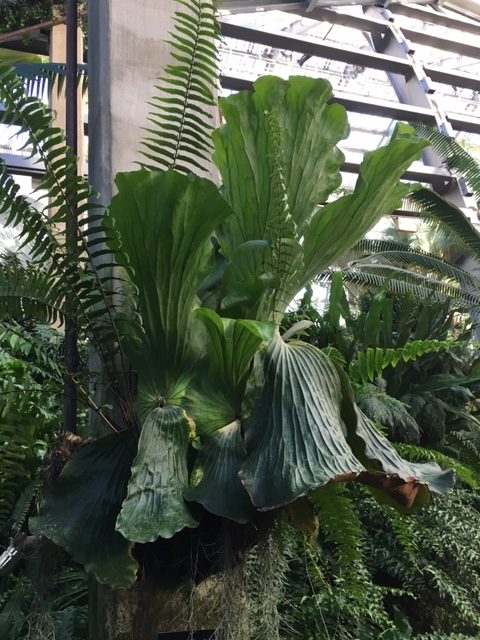
A Michigan cottage I often visited as a child had an old deer head over the door known as George. He’d been there for decades and his antlers were used as a hat rack. But he had an ancient, moth-eaten dignity about him, and I always think of George when I see a grand staghorn fern.
These plants are about the farthest thing from “ferny”—nothing light and lacy about staghorn ferns (although they are ferns, botanically). They have bold, sculptural leaves and the presence to command attention. You may see them grown on walls because of the basic fact of their biology: These are plants that grow on trees.
Staghorn ferns are epiphytes, meaning that they naturally grow above ground, with minimal roots attaching them to tree bark or in crotches. They get their moisture from tropical rainforest rains and mists and their nutrients from the detritus that filters down from the tree canopy.
Although I’ve seen spectacular, unusual, massive staghorn ferns in places such as the Garfield Park Conservatory in Chicago, the one commonly grown as a houseplant or in a home greenhouse is Platycerium bifurcatum (also called elkhorn fern).
Usually, the fern is tied or tacked to a board or a slab of bark, with some growing medium such as moss or fine orchid mix contained by chicken wire or plastic netting that lets water drain away freely. A plant that naturally grows up high where rain flows down and away can’t endure to sit in water.
To grow a staghorn fern indoors, you need to give it a similar environment to the rainforest: moist air or frequent misting, regular watering, great drainage and bright but filtered natural light. They naturally grow high enough to get some light, not too much. In a glasshouse, think about how you’ll protect the plant from harsh summer sun.

Since the board will be moist, be sure to hang it where it won’t cause a problem such as a waterproof wall or rack). To water, you can lift a small plant and soak it in the sink or bathtub. A good rule of thumb is to water once a week, but less often in deep winter, when the plant is dormant.
A staghorn fern won’t likely grow fast indoors, but a plant that’s happy with its conditions can become large and hard to move. At that point—unless you have a conservatory with a concrete floor for easier watering—you may need to divide it to reduce it to a manageable size. Learn more here or here.
A staghorn fern can be a fun statement houseplant, as grand as old George but greener and considerably fresher.










